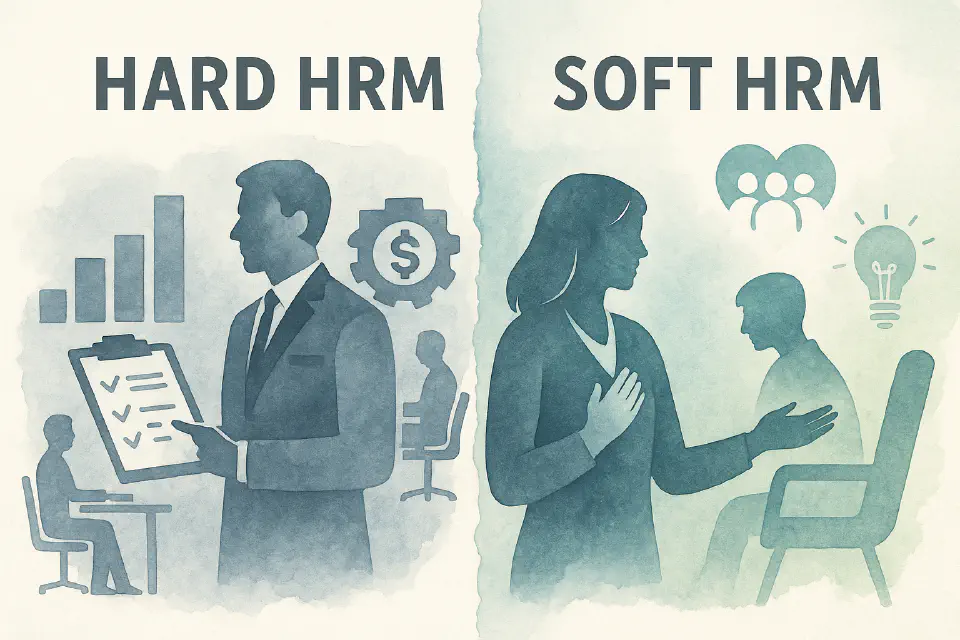
Hard vs Soft HRM
HR isn't one-size-fits-all. The hard vs soft HRM debate reveals two fundamentally different ways of managing people—with real consequences for performance and trust.
The distinction between hard and soft Human Resource Management (HRM) is one of the most enduring debates in the field. While both approaches aim to manage people effectively, they are rooted in different assumptions about human behavior, organizational goals, and the role of HR.
Understanding the tension between them helps HR leaders make clearer decisions about policies, leadership styles, and even technology adoption. It also reveals the ethical and cultural trade-offs embedded in everyday HR practices.
What Is Hard HRM?
Hard HRM views employees primarily as resources—like equipment or capital—to be optimized for maximum efficiency. The focus is on quantitative metrics: headcount, productivity, cost control, and performance outputs.
Hard HRM often emphasizes:
- Strategic planning linked to corporate goals
- Tight control over labor costs
- Clear structures and procedures
- Use of HR metrics and KPIs
- Centralized decision-making
This approach is especially prevalent in industries where scale, consistency, and efficiency are critical—such as logistics, manufacturing, and finance.
What Is Soft HRM?
Soft HRM, on the other hand, sees employees as valued individuals and potential sources of competitive advantage. It focuses on development, motivation, engagement, and alignment with organizational values.
Soft HRM emphasizes:
- Individual development and career paths
- Employee engagement and empowerment
- Open communication and participative leadership
- Organizational culture and values
- Adaptability and flexibility
It is often found in knowledge-driven industries like tech, design, education, and services, where creativity, autonomy, and collaboration are essential.
Historical and Theoretical Roots
The hard HRM view aligns closely with Scientific Management and Strategic Control theories, which emerged during the industrial era. These theories assume that work can be broken down into tasks and optimized through rules and supervision.
Soft HRM evolved from the Human Relations Movement and Behavioral Science, which emphasized motivation, job satisfaction, and social dynamics. Later, it found support in theories like McGregor’s Theory Y and Deci & Ryan’s Self-Determination Theory.
Strategic Implications
The choice between hard and soft HRM affects every layer of strategy and operations:
- Recruitment: Hard HRM focuses on filling roles efficiently. Soft HRM looks for cultural fit and potential.
- Training: Hard HRM invests only when ROI is clear. Soft HRM sees learning as part of employee value.
- Performance Management: Hard HRM favors strict targets. Soft HRM includes feedback, coaching, and growth.
- Retention: Hard HRM often tolerates turnover. Soft HRM seeks long-term engagement.
Neither approach is “right” or “wrong”—but using one unconsciously can misalign HR with organizational goals.
Risks and Ethical Considerations
Hard HRM can lead to:
- Short-termism and burnout
- Lack of employee voice
- Undervalued human potential
Soft HRM, if not grounded in reality, may result in:
- Poor accountability
- HR practices that are inconsistent or hard to scale
- Decision-making driven by sentiment over data
Real-World Application: Blending the Two
Most modern organizations don’t choose one model—they blend both. For example:
- Using hard HRM for compliance, budgeting, and performance tracking
- Using soft HRM for leadership, development, and engagement
Cultural and Global Variations
Approaches vary by national culture. For example:
- U.S. firms often blend both but lean toward performance-driven models (hard).
- Nordic countries tend to favor soft HRM through social dialogue and trust.
- East Asian firms may integrate collective hard-soft models tied to loyalty.
Understanding these variations helps international HR leaders adapt without imposing the wrong model.
Conclusion
Hard and soft HRM represent more than techniques—they reflect core beliefs about people and organizations. In reality, both are needed. The challenge is not choosing sides, but understanding when and how to apply each.
By mastering this balance, HR can drive performance while protecting humanity. And that’s what strategic HRM is really about.